Travelers and tourist embarking on explores can immense into the Kenyan culture through their delicious dishes and meals. Some of the Kenya foods are friendly to any class of people whether vegan or those on diet. Some are halal which can be eating by all.
While having a great within the jurisdictions of Kenya, sit and relax at the restaurant near you, take the table menu and look out for these delicious, appetizing and healthy foods.
What Kenya foods are famous or popular?
- Ugali (Cornmeal Staple)
Ugali also known as Nsima is an East African staple meal among the indigenous people. It is like a porridge but much more dense made from white maize meal or maize flour. It is generally served with a vegetable or meat stew. People at the coast and around Lake Victoria enjoy it with fish.
Ugali is also served with nyama choma which is grilled meat and kachumbari, a tomato onion salad. One of the most easiest dish to prepare, it is not only rich in fiber but also is a good source of carbohydrates, minerals and Vitamin B. And it is gluten free and vegan friendly.
Ugali is best enjoyed with your hand rather than a spoon or fork. A small lump of the mixture is rolled into a ball using one hand. A depression is made in the middle with the thumb and it is used to scoop the stew. But in modernity, people rather use spoon and fork to eat Ugali when in the restaurants or eateries.
Recipes
Ingredients
- 1 cup maize meal / corn meal
- 2 cups normal water
Instructions
- Heat water over medium heat in a deep pan. Make sure you take a pan with a handle.
- Sprinkle about 1 tbsp of the maize meal while the water comes to a boil.
- Add the maize meal or cornmeal and keep on stirring with a strong wooden spoon.
- Keep stirring and pressing the mixture against the sides of the pan to break up the lumps.
- As the mixture becomes thicker, it becomes more difficult to mix but keep mixing and breaking up the lumps.
- The mixture with begin to come away from the sides of the pan.
- Allow it to cook for 2-3 minutes.
- At this point either transfer the ugali to a platter from the pan. Place the plate over the pan and turn it upside down.
- Or you can transfer to a small heatproof bowl. Pat it down into shape. Place a plate over the bowl and turn it over.
- Enjoy piping hot ugali with your favorite stew or curry.
- Sukuma Wiki (Collard Greens / Kale)
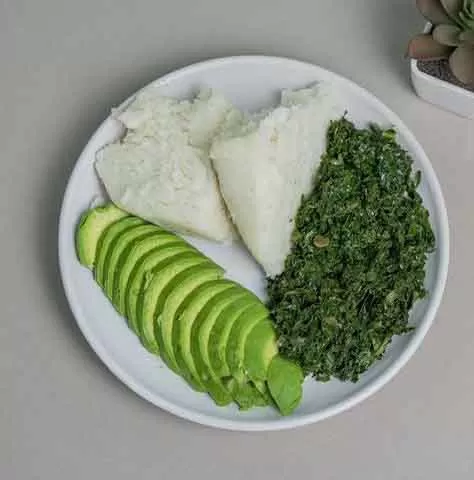
Sukuma wiki is a very rustic African dish, enjoyed in many parts of East African countries like Kenya, Tanzania- just to name a few. It is a Swahili phrase meaning, “to stretch the week” especially when paired Ugali (cornmeal fufu).
This tasty African greens can be made totally vegan or cooked with just a few ingredients or you can take it over the top with protein and spices.
Recipes
Ingredients
- 1 kale bunch or collard greens
- 1-2 cups chopped or ground beef/chicken optional
- 3 medium tomatoes diced
- 1-2 teaspoons minced garlic
- 1 large white onion
- 2 or more tablespoons canola or cooking oil
- 1 Tablespoon smoked paprika
- ½ teaspoon coriander
- 1/2 teaspoon curry or turmeric spice
- ½ teaspoon cayenne pepper or more
- ½ juiced Lemon about 1 tablespoon
- Tablespoon bouillon powder or cube
Instruction
- In a medium- large skillet, add oil, onions, and garlic, and sauté, for about 2-3 minutes, stirring constantly to prevent any burns.
- Then add tomatoes, curry, coriander and paprika, and continue stirring with a heavy wooden spoon, about 2 minutes.
- Add minced meat, bouillon powder; stir until ingredients have been thoroughly combined. Simmer for about 5 minutes or more. Throw in chopped collards, cayenne pepper, lemon juice, Continue cooking for another 5-10 minutes until flavors have blend and greens are cooked, according to preference. Adjust seasonings –Salt and pepper, turn off the heat.
- Remove from the heat and let it cool. Serve your Sukuma with Ugali.
- Irio or Mukimo (Mashed Peas and Potato Mix)
Mukimo (Irio) is a meal that has a Kenyan origin. It is consumed as a main meal in the course meal. Kenya has different tribes that enjoy it. It is traditionally served as the main dish of a meal, now in many parts of Africa.
Recipes
Ingredients
- Irish potatoes
- Corn kernels
- Beans or peas of choice
- Pumpkin leaves (I used spinach)
- Tablespoon of salt
- Cooking oil
- Onion
Instruction
- Peel the potatoes and rinse them. Keep them in a bowl, covered with clean water.
- Shell the corn and remove the grains from the cobs. This is to ensure that it is easier to boil them.
- Mix the corn kernels with beans or peas, based on what you have available. The result of this mixture is termed as “githeri”. It is the signature ingredient in the making of mukimo.
- Boil the githeri till all the constituents are well cooked.
- When the githeri is ready, drain the remaining water and place the mixture into a separate bowl.
- Boil the potatoes, adding some salt to ensure that the potatoes are tasty. When they are well cooked, soft when stuck with a fork, drain the remaining water and place the potatoes in a separate bowl.
- Chop the greens you’ve chosen into thick slices on a chopping board. Boil them until they are soft, only for a few minutes (depends on the type of green used). This ensures that the greens soften and makes it possible to produce the green color easily.
- Lightly blend the boiled leaves to ensure that they will be easily distributed when it is time to use them in the preparation.
- Mash the boiled potatoes until every bit of the potatoes is well mashed.
- Add the githeri to the already mashed potatoes, and ensure they are well mixed to create a uniformly formed solid mass. Add salt to taste.
- Place the blended leaves into the bowl containing the mixture, and mix them gently and uniformly to give the dish its signature green color.
- Add a teaspoon or so of cooking oil to a heated skillet. On medium-low heat, sauté the onions until they are translucent.
- Stir the mukimo into the sautéed onions and oil until they are fully incorporated. Your mukimo is now ready to serve!
- Githeri (Beans and Corn)
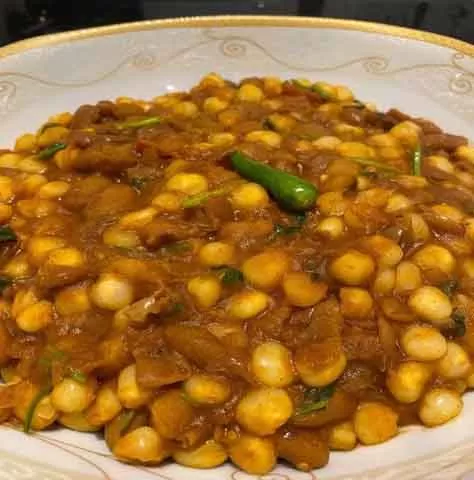
Githeri is a traditional Kenyan dish that is made with beans and corn. It is typically served alongside other dishes, such as maize flour porridge or Chapati (wheat flatbread). The word “Githeri” means mixed in Swahili.
This delicious dish combines many flavours to create a hearty meal, which has been said to be the staple food of Kenya for centuries.
Githeri is a dish associated with the Kikuyu tribe, who are known for this dish and typically use red beans in their githeri recipes. Green mung beans or black-eyed peas, on the other hand, may be used in githeri prepared by different tribal communities in Kenya.
Recipes
Ingredients
- Kidney beans
- Corn kernels
- Tomatoes
- Spices
- Onions
- Vegetable oil
- Vegetable broth
- Garlic
- Cilantro
- Salt
Instructions
- In a large pan, add olive oil over medium heat. Once heated, saute onions for a couple of minutes until lightly golden and translucent in appearance (Image 1).
- Stir in garlic, smoked paprika and curry powder. Cook on low heat while stirring for a minute (Images 2-3).
- Now, add tomatoes; cook for three minutes or until the tomatoes are soft and mushy (Images 4-5).
- Next, stir in beans, corn kernels, stock and salt; cover the githeri mixture and reduce heat to low-medium (Images 6-7). Simmer for about 8 minutes, stirring occasionally (Image 8).
- Garnish githeri with spring onion (scallion) and cilantro
- Kenyan Pilau (Spiced Rice)
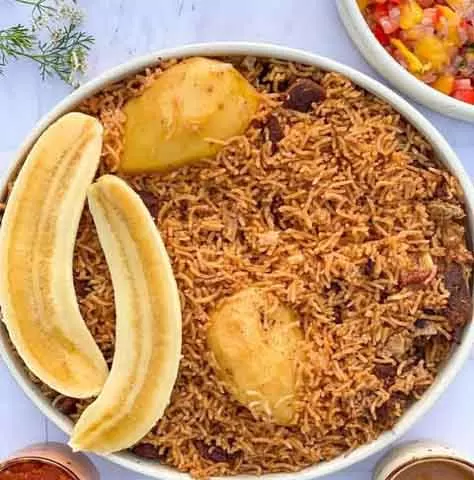
Pilau is a traditional, beautiful fragrant rice dish made with many aromatic spices that adds an amazing depth of flavor to the rice. It can be made with either beef or chicken.
Pilau has a wonderful balance of flavors. It is a festive dish, which is never missing during special occasions or events. It’s made with rice cooked in a well-seasoned broth of Meat or chicken.
Enjoy the Pilau which the East African version of Jollof.
Recipes
Ingredients
- Toast and blend the pilau masala: In a medium saucepan over medium heat.
- Brown the onions by frying it in oil until it caramelizes. This should take about 10 to 15 minutes. Stir in the Garlic, ginger and serrano pepper.
- Add the meat stock cubes, pilau masala, cilantro, bay leaves, and salt to taste and brown the meat for about
- Stir in the tomatoes and cook till it dissolves. Then stir in the potatoes.
- Add water and bring everything to a rolling boil and leave the potatoes to cook for about 10 minutes.
- Stir in the rice then cover tightly. You can use an aluminum foil to cover it first, this will help keep the steam in. Then place the lid over it and leave to cook on a low heat for 20 minutes until the liquid has been absorbed.
- Serve hot!You can sprinkle the rice pilaf with some chopped cilantro, then fluff with a fork. Enjoy.
- Wali wa Nazi (Coconut Rice)
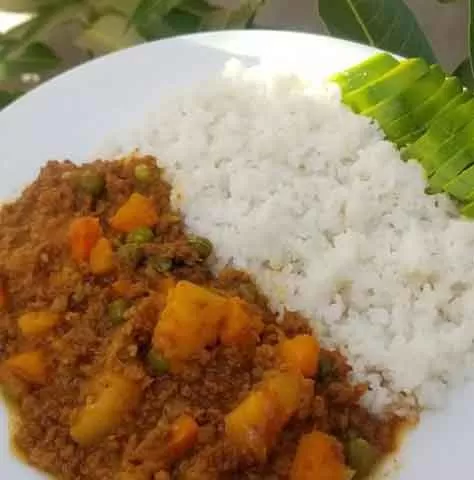
Wali wa Nazi is a Swahili dish popular on Africa’s Indian ocean coast, particularly in Swahili areas like Zanzibar, Lamu, Malindi, and Mombasa. It is a creamy, rich accompaniment to any meat, chicken, fish, or curry.
Recipes
Ingredients
- cups coconut milk
- 2 3⁄4 cups water
- 2 cups rice
- 1 teaspoon salt
Instruction
- Clean and wash rice.
- Bring the coconut milk and water to a boil.
- When boiling, pour in the rice.
- Add salt.
- Leave to cook on medium heat.
- When nearly dry, cover well.
- Turn down the heat and leave to cook for 10 minutes.
If you have Rice cooker, put all of the ingredients in the rice cooker and turn it on.
- Kenyan Stew
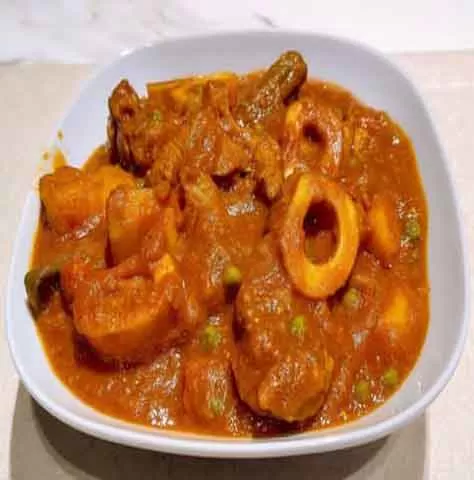
This aromatic stew is a favorite dish in many Kenyan households because it pairs extremely well with a starchy Kenyan staple known as ugali. Apart from ugali, Kenyan stew can also be paired with rice or chapati on the side.
Although Kenyan stew can be prepared with goat or chicken, the most popular and traditional version is made with chunks of beef, oil, onions, curry powder, tomatoes, coriander, and garlic. The base is typically prepared with ingredients such as peppers, peas, potatoes, and carrots.
Recipes
Ingredients
- 1 ½ lbs. boneless beef chuck roast, cut into bite size pieces
- 1 to 2 tbsp. cooking oil
- 2 medium onions, chopped, about 2 cups
- 3 large cloves garlic, chopped
- 1 jalapeno pepper, chopped, seeds removed for less heat
- 1 tbsp. chopped fresh ginger root
- 1 tbsp. tomato paste
- 3 medium tomatoes, chopped, about 1 pound
- 1 tsp. curry powder
- 1 tsp. paprika
- ½ tsp. freshly ground black pepper
- 3 to 4 cups beef broth or water
- 2 to 3 tsp. kosher salt, to taste (depending on if you use salted beef broth)
- 2 large carrots, cut into chunks, about 2 cups
- 2 large new potatoes, cut into chunks, about 2 cups
- 1 to 2 plantains, depending on size, peeled and cut into chunks, about 1 ½ to 2 cups, (the one I used weighed 12 oz. with the peel on)
Instructions
- Start by browning the beef cubes in a large frying pan, drizzled with a little bit of oil. You may have to do this in two batches to avoid crowding the pan and thereby steaming the meat instead of browning it. Remove the beef cubes and put them into a large pot or Dutch oven that the stew will finish cooking in.
- Once the beef is browned drizzle a little more oil into the pan and add the chopped onions; keep the heat to low, and let the onions cook until they soften and pick up the color of the meat juices left on the bottom of the pan. Next add the garlic, jalapeño pepper, and ginger, stir that around for a minute.
- Add the tomato paste and mix it in thoroughly with the vegetables in the pan, let the tomato paste caramelize for a minute or so. Add the chopped tomatoes, curry powder, paprika, and black pepper. Stir that around for a few more minutes, until the tomatoes start to break down and become saucy.
- Scrape the contents of this pan into the stew pot with the meat. Add 3 cups of stock or water to the pot, but make sure to add some to the frying pan you just used in order to clean and deglaze the pan, and add that liquid into the stew pot as well.
- Bring the stew to a simmer and add the carrots. I wouldn’t add the potatoes and plantains just yet because they don’t take as long to cook as the carrots do. BUT, it depends on how firm your plantains are. If they are quite firm then add them in along with the carrots. If not, add them in with the potatoes.
- Add the salt now too, start by adding 2 teaspoons at first. You can taste later on to see if you still need to add more. Simmer the stew, covered, for 30 minutes.
- Add the potatoes, and plantains if you haven’t already done so, and let the stew simmer for another hour. Stir occasionally, you may have to add another cup of stock, depending on how you like your stew. I ended up using 4 full cups. Check to see if the meat is tender. It should be, but if not, simmer longer until it is fork tender.
- You could serve this with rice or ugali, but that is not really necessary since there is plenty of starch in the stew. Enjoy!
- Nyama Choma (Roasted Meat) – Pride of Kenyan Food
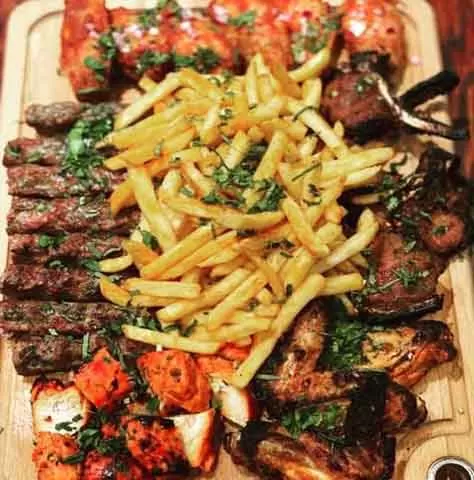
In Kenya, any gathering is an excuse for eating nyama choma, Swahili for “roast meat.” From the finest restaurants to roadside shacks, roast goat meat is served up as a kind of social lubricant, often aided by copious amounts of the local beer.
Nyama choma is always eaten with the hands, and common side dishes include kachumbari salad and ugali.
Recipes
Ingredients
- Goat or beef meat, cut into bite-sized chunks — 2 pounds
- Oil — 3 tablespoons
- Warm water — 2 cups
- Kosher or sea salt — 2 tablespoons
Instruction
- Prepare your grill and have it hot. Toss the meat with the oil, then thread it on skewers. Stir the salt into the warm water until it is fully dissolved.
- Grill the skewered meat, basting it occasionally with the salt water, until it is cooked to your desired doneness.
- Remove the meat from the skewers and serve with kachumbari salad and ugali.
- Matoke (Plantain Banana Stew)
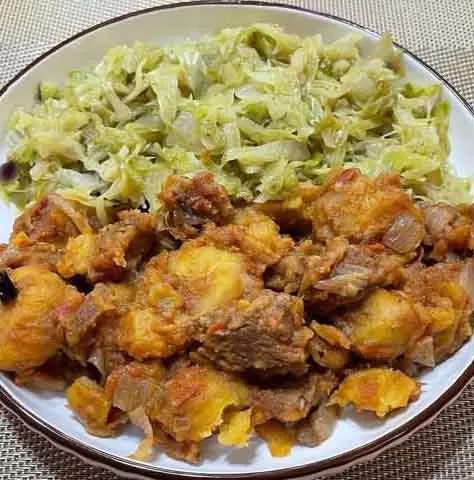
Matoke is a simple, healthy, and delicious one-pot East African dish made from green bananas. This dish is eaten eaten at lunch or dinner. This staple food is made from green beans. It is most popular in Burundi, Uganda, Rwanda, and Kenya, but it’s also eaten throughout the region.
Recipes
Ingredients
- Matoke
- Oil
- Onion
- Lamb or beef
- Spices (paprika, cayenne pepper, garlic, ginger, curry powder, chicken bouillon powder, salt, and pepper)
- Tomatoes
- Water
- Herbs
Instruction
- Peel and cut the matoke into 1.5 – 2 inch pieces. Put them in water till you are ready to use them so that they don’t become discolored.
- Heat the oil in a large skillet over medium-high heat, add onions, and cook until soft, about 2 minutes.
- Stir in the garlic and ginger and cook until fragrant—a few seconds.
- Stir in the beef and add the paprika, curry powder, bouillon powder, salt, and pepper. Mix well, cover, and leave to cook for 10 minutes, stirring halfway between.
- Add the matoke, diced tomatoes, and stock (or water), stir, cover, and leave to simmer for 25 to 30 minutes or till the matoke becomes tender.
- Stir in the coriander and serve.
- Chapati (Flatbread)
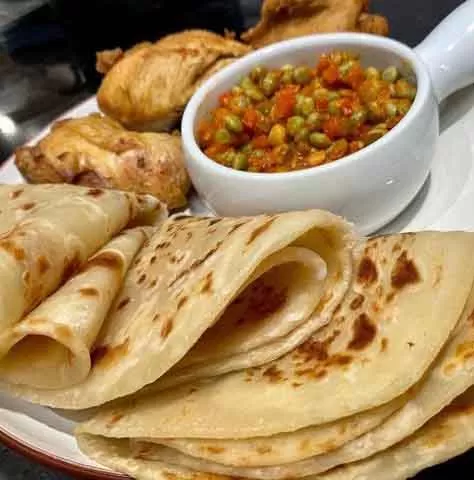
Chapati is a popular unleavened bread among East African countries like Kenya, Uganda,Tanzania, Mozambique,and so on.
Recipes
Ingredients
- 3 cups all purpose flour
- 1 teaspoon sugar
- 1 1/2 teaspoon salt
- 3 tablespoon ghee (Clarified butter) or oil
- 1 1/4 cup warm water
Instructions
- In a large bowl add flour and make a well then add sugar , salt, followed by water , ghee or oil
- Knead to form a soft and sticky dough.
- Place dough on a heavily floured board and knead for about 8-14 minutes. Continue to flour dough as needed to facilitate kneading. Be careful not to over do it. Dough should be soft , elastic and smooth.
- Divide dough into 6 or 8 pieces according to preference and let it rest .The resting of the dough helps to relax the gluten and make it not only easier to work with but also produces tender chapati.
- Using a rolling pin roll out dough into a circle. They do not have to be perfect circles.
- At this stage you may proceed to cooking. However, if you want chapatis with layers you have to do the next steps.
- Lightly oil chapati dough with ghee. Be gentle with the oil.
- Then place dough on a heavily floured plate, press the dough down.
- Turn dough over and press down – lightly shake off excess flour.
- Shape dough like you would shape a paper fan- Starting at one end, all the way to the opposite end.
- Then coil l it up- like in the picture.
- When all the dough has been coiled up , cover the dough with a damp cloth and let them rest for 20 minutes.
- Glently flatten out coiled dough and roll out . Begin rolling out the dough from the center working outwards.
- Rotate the dough out each time you roll it . This helps to make a perfect circle. Make sure they are not roll out to thin . Chapatis are not meant to be thin- 1/4 inch dough thickness is good.
- Oil pan. Then place dough on the pan. I used crepe pan to make this chapati- a skillet will work as well.
- Heavily oil the other side of the dough making sure you oil the edges too.
- Cook for about 2-3 minutes rotating as need until golden brown.
- Serve warm.
- Kachumbari (Tomatoes and Onions)
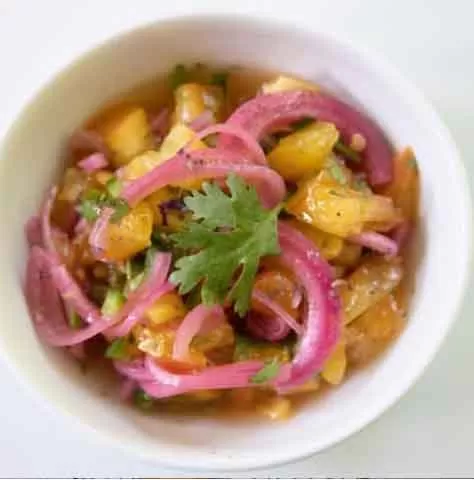
Kachumbari is a fresh tomato and onion salad that is popular in East Africa, particularly in Kenya, but also in Tanzania, Rwanda, Burundi, and Uganda. This salad with a Swahili name is popular as a side dish or condiment for summer-time grilled meats and rice dishes.
Recipe
Ingredients
- ½ medium red onion, diced
- 1 tsp salt
- 2 large tomatoes
- ¾ avocado
- 1 small chili (optional)
- ½ lime, juiced (approx 1 Tbsp juice)
- 1 Tbsp fresh cilantro chopped
Instructions
- Place the diced onion in a small bowl and massage the salt into the onion pieces. Cover the salted onions with water and let stand for 10 min.
- Meanwhile, dice the tomatoes, avocado, and chili (if using). Place them in a medium bowl.
- Drain the onions and add them to the vegetables.
- Finish by adding the lime juice and cilantro.
- Mix well and taste the salad. Add salt or more lime juice if desired.
- Kenyan Bajias
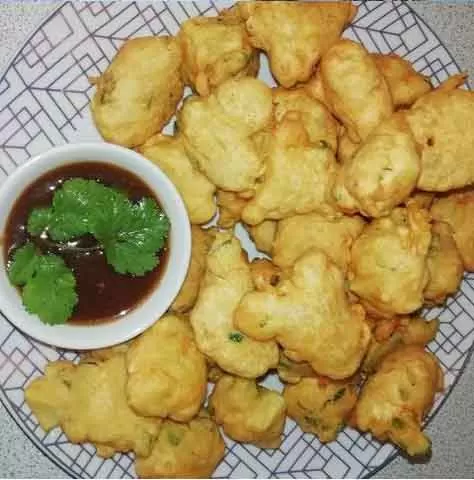
Kenyan Bajias are seasoned, battered and fried potatoes that are found all over Kenya. It is a very popular street food that was influenced by the Indian population who were brought there to work on the railroad. The potatoes are sliced thin, and then placed in a batter that is seasoned up with the flavors of India.
Recipes
Ingredients
- 2 medium potatoes
- 1 cup chickpea flour
- 1/4 cup rice flour
- 1/4 teaspoon turmeric
- 1/4 teaspoon ground cumin
- 1/4 teaspoon black pepper
- 1 teaspoon salt
- 1/2 teaspoon dried fenugreek leaves
- 1/2 teaspoon red chile powder
- a pinch of garam masala
- 1/2 teaspoon ground coriander
- 2 teaspoons ginger minced
- 1/4 cup fresh cilantro chopped finely
- 1 cup water
- oil for frying
Instructions
- In a large bowl combine the flours, and all the spices.
- Add in the cilantro and slowly add in the water until you have a thick batter. Add more or less water as necessary.
- Slice the potatoes using a mandolin or knife
- Heat the oil to medium high heat.
- Place the potatoes in the batter, coating each piece well on both sides
- Put in the hot oil and fry until golden and flip to repeat on other side
- Remove from oil and place on a paper towel to remove excess oil
- Do this until all the potatoes are cooked.
- Serve hot with madras (mango chutney)
- Masala Chips (French Fries Masala)
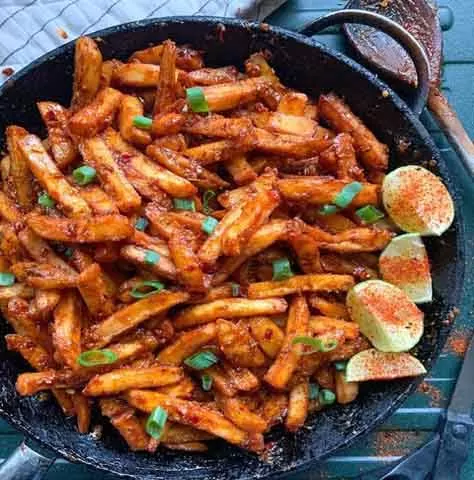
These easy masala fries are made with crispy fried potatoes tossed with flavourful garlic, onion and tomato masala sauce. A delicious appetizer that takes just a few minutes to prepare. Made with simple pantry-friendly ingredients and faster than ordering Indian takeaway chips!
Recipes
Ingredients
- 2 tablespoons vegetable oil
- ¼ medium red onion, finely chopped
- 1 medium tomato, diced
- 1 serrano chile, seeded and finely chopped
- 2 cloves garlic, minced
- 1 ½ teaspoons garam masala
- ¼ teaspoon turmeric
- ½ teaspoon ground cumin
- 1 teaspoon lemon juice
- 2 tablespoons fresh cilantro, finely chopped
- 1 lb french fries (455 g), cooked, hot
- salt, to taste
Instruction
- Heat the oil in a large pan over medium-high heat, then add the red onion and cook for 5 minutes, until browned.
- Add the tomato, serrano, and garlic. Stir well, cover, and cook for 5 minutes, until the tomatoes have softened.
- Add the garam masala, turmeric, and cumin. Stir, reduce the heat to medium, and cook for another 10 minutes, or until the sauce clings to the potatoes and they soften slightly.
- Stir in the lemon juice and cilantro, then add the fries and salt. Toss well to coat. Serve immediately.
- Enjoy!
- Mandazi (Kenyan Doughnut)
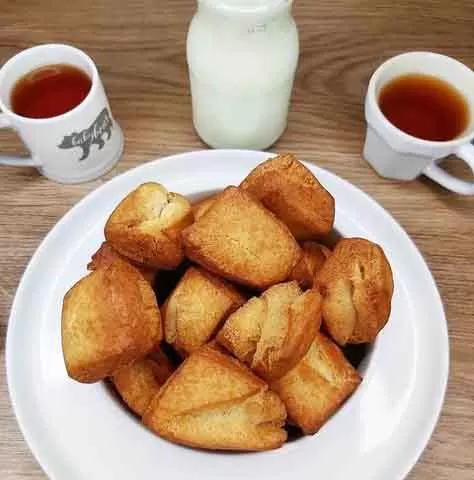
These amazingly soft triangle-shaped donuts are very famous in East Africa where I come from. They are excellent with a cup of tea or coffee. The dash of cardamom adds an authentic taste which makes it different from regular donuts. Mandazi can be served with either honey or jam.
Recipe
Ingredients
- 1 cup warm milk
- ¼ cup vegetable oil
- ¼ cup fine white sugar
- 1 medium egg
- 2 teaspoons instant yeast
- ½ teaspoon salt
- ½ teaspoon ground cardamom
- 3 ½ cups all-purpose flour, sifted
- vegetable oil for deep frying
Instruction
- Combine milk, 1/4 cup vegetable oil, sugar, egg, instant yeast, salt, and cardamom in a large bowl. Mix in flour, 1 cup at a time, until dough comes together and is easily handled. Knead dough on a flat work surface until no longer sticky.
- Put dough back in the bowl, cover, and let rise in a warm area until doubled, about 1 hour.
- Press dough down gently. Knead it briefly and divide it into 4 portions. Roll each portion into a ball; keep covered with a cloth to prevent them from drying out.
- Roll 1 ball into a 1/3-inch-thick circle on a floured work surface. Cut into 4 triangles using a pizza cutter. Repeat with remaining balls of dough, keeping other dough covered.
- Heat oil in a deep-fryer or large saucepan over medium heat. Fry dough triangles 3 or 4 at a time, without overcrowding, until puffed like balloons, 1 to 2 minutes. Turn and continue frying until golden brown, 1 to 2 minutes more. Drain on paper towels. Repeat with remaining dough.
- Mutura
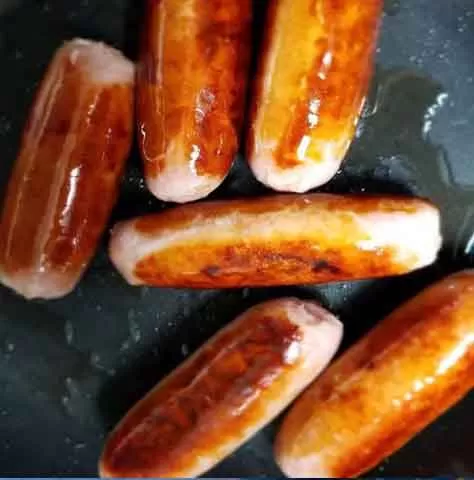
Mutura is a fire-grilled delicacy made from goat or cow or lamb intestines sewn together and stuffed with a mixture bound by fresh blood and with a combination of seasonings such as ginger, garlic, coriander, and piri-piri chilies. Mutura is part of the global tradition of blood sausages.
Recipes
Ingredients
- 3 tablespoons chopped onions
- 1/2 teaspoon chopped garlic
- 1 tablespoon oil
- 3/4 kg boneless forequarter of Beef
- 1 green chili chopped
- salt and pepper
- 1 tripe approx. 200 gms
- 1 cup blood
Instruction
1. Cook onions and garlic in oil until onions are golden brown.
2. Cool them. Cut the Beef into small cubes.
3. Mix with blood and season with salt, pepper and chili.
4. Place the mixture in the uncooked tripe and tie both ends firmly.
5. Grill. Slice to serve.
6. Traditionally this is served with ugali or githeri.
- Kenyan Burger
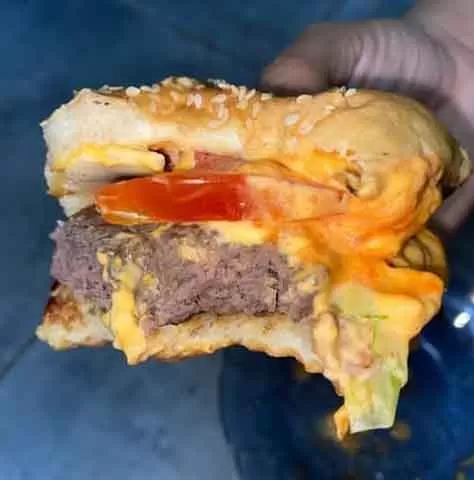
Enjoy the Kenyan version of a sandwich consisting of one or more cooked patties, placed inside a sliced bread roll or bun roll.
Recipes
Ingredients
- 500g minced Beef
- 2 cups Bread crumbs
- 2 Eggs
- Tomato (sliced)
- Cucumber slices
- Lettuce
- 1 tablespoon Mixed Herbs
- 1 bunch Cilantro/Dania (chopped)
- Burger buns
- Onion rings
- Cheddar cheese (sliced)
- Some cooking oil for frying
- Chillies (optional)
- Salt
Instruction
- In a large bowl mix the minced meat, bread crumbs, chopped dania, mixed herbs, salt, chilies and eggs.
- Mix lightly just to allow all the ingredients to combine, be careful not to overwork the meat.
- When ingredients have combined, use a serving spoon to scoop portions of the meat mixture for rolling.
- With clean hands roll each scoop into a ball, press it down until it is about a centimetre thick and set aside, covered with cling film.
- In a large pan or on a grill, fry the patties until well cooked.
- Assemble the burger by spreading some mayonnaise, some vegetables and beef in between them.
- Samosas
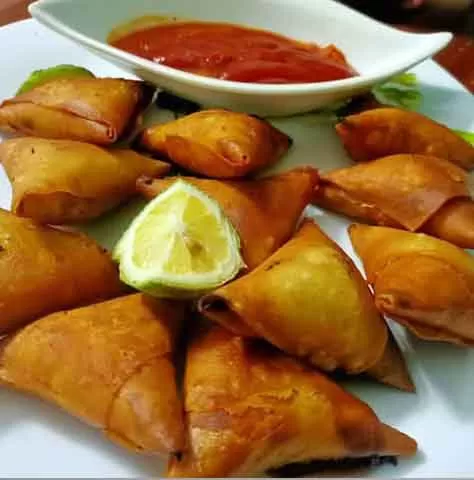
Recipes
- /2 kg of minced beef
- 4 large onions
- If you have any spring onions in hand use those, they have amazing flavor!!
- 4 cloves of garlic
- Fresh minced ginger
- Dhania/coriander
- Fresh chillies/ chili flakes
- 2 tablespoons of coriander
- 1 tablespoon of cumin
- 1 tablespoon of thyme
- 2 tablespoons of paprika
- 1/2 teaspoon of turmeric
- Black pepper
- Salt
- 1 tablespoon of vegetable oil
- Oil to deep fry
- Samosa pastry/ skins
Instruction
- Sautée the onions for about 3 minutes in 1 tablespoon of vegetable oil until they soft and translucent.
- Add in the fresh ginger and garlic and allow this to cook for about 2 minutes until everything is well cooked and fragrant.
- Next in, add the spices. That is, the coriander, cumin, paprika, thyme, turmeric and black pepper.
- Let the spices cook and roast for about a minute to bring out their full flavors.
- Add in the minced meat and cover. Lower the heat to a medium low heat. Let the meat produce its own liquid, cook and dry up.
- Once it dries up, stir and season with some salt.
- Add about 1/4 a cup of water to cook the meat further.
- Let the water dry down but not too dry that it ends up gritty. Ensure the meat still has some moisture in it. This ensures a nice juicy samosa!
- Add in the chillies and dhania. Stir for a quick minute and turn of the heat.
- Taste the meat filling and MAKE SURE THAT THE FILLING IS WELL SEASONED. Add some salt if need be.
- Let this cool slightly before filling the samosa skins.
- Fold the skin of the samosa. Make the glue by mixing some flour and water until its a thin glue consistency.
- Heat the vegetable oil. Test the temperature by dropping in a small piece of dough. Count 3 seconds…if the dough rises at 3, then the oil is ready. If the oil is too hot, the samosas get blemishes or bumps on the top. If the oil is not hot enough, then they become a soggy mess. Therefore, keep the heat on medium throughout the cooking period. After every batch, recheck the temperature by throwing in a piece of dough and counting to 3.
- Deep fry the samosas in small batches making sure the pan is not overcrowded.
- Enjoy your Samosa.
- Chai (Kenyan style tea)

Recipes
- Water
- Whole milk
- For extra flavour, take spice/seasoning such as Tropical Heat‘s Tea Masala (ground ginger, cinnamon, cloves, cardamon, black pepper and nutmeg)
Instruction
- Mix the water and milk into the pot. For each cup of milk, match it with a cup of water i.e. one cup of milk, one cup of water. Should you prefer to have a thinner percentage of milk, you can simply adjust the ratio to 1 part milk and 2 parts water. If you want that “kick” in your tea, you will add a small serving of tea masala to infuse with the mixture at this first stage.
- Set it up on the stove and bring the mixture to a boil. Some folks add sugar/sweetener to the boiling mix before serving. However, if you have a guest who does not take sugar, you may want to hold off on adding it. Also, this is the point where “nylon” is created – nylon is the boiled mixture of water and milk that can be used to make hot chocolate or instant coffee/tea.
- Turn off the heat before the mixture boils over the pot.
- Add a spoonful of tea leaves and stir to mix it all around. At my house, we would rather do this rather than let the tea leaves boil together with the nylon because it can make the tea too strong.
- Cover the pot and wait 3-5 minutes.
- Filter into a thermos, teapot or jug using a tea strainer/sieve.
- Pour into a cup, add sweetener and enjoy your chai!
- Maharagwe
Maharagwe, also known as maharage ya nazi, is a popular Swahili dish which is made from red kidney beans, very simple spices, tomatoes and coconut milk. In the Kiswahili language maharage is red kidney beans and nazi is coconut.
The dish can be prepared in both sweet and savoury versions and it is usually served with chapati bread or ugali (a type of maize flour porridge). Kidney beans or red beans are a staple food in the East African diet.
Recipe
- ½ lg. yellow onion, chopped
- ½ lg. red bell pepper, chopped
- 2-3 cloves garlic, minced
- 2 tsp. ground turmeric
- 2 tsp. ground cumin
- 1 tsp. ground coriander
- ¼ tsp. ground cardamom
- Fat pinch crushed red pepper flakes
- 1 tsp. ginger paste
- 1 medium jalapeño, chopped
- 2 tps. agave
- Salt to taste (I used ~1 tsp.)
- Black pepper to taste
- 2 15-oz cans kidney beans, drained
- 1 14.5-oz can diced tomatoes (I like fire-roasted), WITH the juice
- 1 13.5-oz can full-fat coconut milk*
- 1 cup water
- Optional: fresh cilantro, toasted almond slices
Instruction
- Sauté onions, bell pepper, and garlic in ¼ inch of water in a soup pot over medium heat until soft, 7-10 mins.
- While the veggies are cooking, measure out your spices into a pinch bowl and open your cans.
- Add all spices, including the ginger paste, plus the jalapeño. Stir to create a paste-like consistency and cook about one minute, not allowing the mixture to get too dry (add a splash of water if needed).
- Reduce heat to low and stir in the agave, salt and pepper, beans, tomatoes, and coconut milk. Add water to thin to desired consistency.
- Simmer at least 20 mins, stirring occasionally.
- Serve with fresh cilantro, toasted almonds, and corn bread.
Get the recipe videos from here
Thank you for reading.
